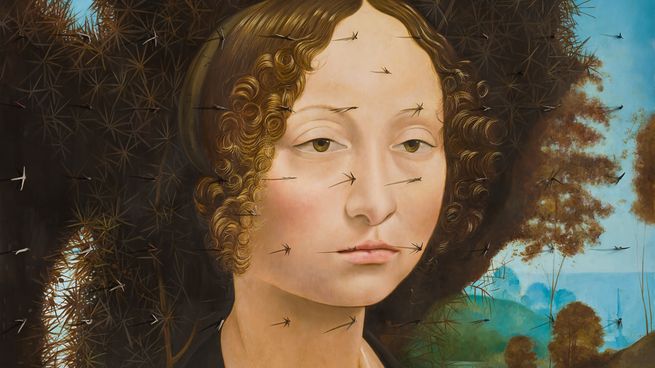In his new sample, “the time and the visible”, exposes 15 of his works in which he cites relevant artists who painted portraits or self -portraits
It’s been quite some time since Martín la Rosa (Buenos Aires, 1972) Dialogue with the greats of art. Who is it? Among them Leonardo, Rembrandt, Vermeer, Ghirlandio. Hence the seduction he exercises on the one who looks at these emblematic works, has been seen personally or in reproductions.
The content you want to access is exclusive to subscribers.
These quotes to the artists who painted portraits or self -portraits are altered by perforations, acacia thorns and other elements that modify, in a way, the artist’s obsession and we could even say, reverential fear for these works, for example“The Jewish bride”, “Portrait of Ginevra de Benci”, “The Lady of the Armed”, Among others.


There are several artists who have dealt with Martín la RosaFor example, Guillermo Roux that approached his early work: tables with white tablecloths and his folds, a way of approaching dead nature or still life, on them, lemons, glass jars, vessels, flowers, with his own life as well as portraits of beings that the artist looks like he sees them, “without attributes, in their silent dignity.”
Pedro CanoSpanish painter, who referred to his portraits as “concise, essential.” The Argentine critic Albino Diéguez VidelaHe pointed out that his impeccably organized surfaces, “describe a sharp lyricism and extreme desolation.” Eduardo Stupía in its double character of artist and curator of the exhibition “The appointment”he wrote that it would be “of the painting citing painting”, a sample that revealed to the rose that dared to dialogue with the great ones named at the beginning of the note.
Pablo Gianera It refers to the artist’s trips to New York to visit the famous “self -portrait” of the Frick Collection of 1658 of its own aging and also to the introduction of some openwork flies of a portrait of their youth, that is, the drafts, according to Gianera “are a kind of emblem of the ravages of time”.
The artist had discovered the sea and forests and for a show entitled “The sum of the days” in 2011 invited us to write a prologue about that landscape that came with mental peace. We then appeal to a Chinese thought: “Outside, I take nature as a teacher, inside, I follow my own heart.”
Florencia Battitiauthor of the introductory prologue to the sample entitled “Time and the visible”15 relevant works, of those that transcend, that are not forgotten, that do not belong to the metalanguage of the banality, mentions some that have been intervened with fire, earth and air, a gesture of the art of all time, that of before, the one of now and the usual, indispensable for our existence as the elements of nature.
Closing on June 14. Muntref Visual Arts Museum. Valentín Gómez 4828 Homemade Headquarters. Monday to Saturday from 12 to 20th free admission.
Source: Ambito
I am an author and journalist who has worked in the entertainment industry for over a decade. I currently work as a news editor at a major news website, and my focus is on covering the latest trends in entertainment. I also write occasional pieces for other outlets, and have authored two books about the entertainment industry.




